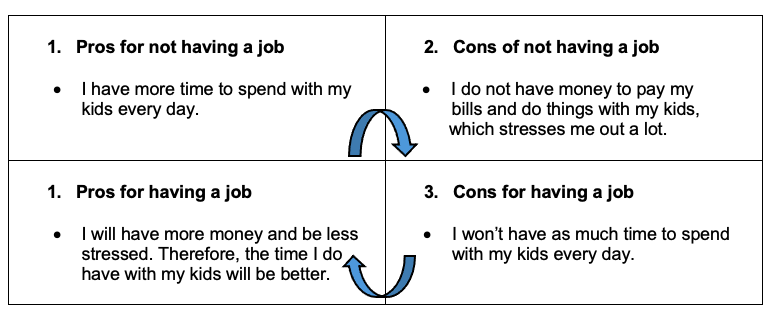Ever work with a client and become frustrated when it appears they are not progressing? Are you baffled when you have worked extensively with a client on their job search only to learn they have not followed through with any of your recommendations? Do your clients tell you how they want to get a job but go back and forth on reasons why they can’t?
A client’s lack of behavioural change could be indicative of their need for further assistance resolving ambivalence to move effectively toward change. In addition to the work we already do, how can we motivate individuals toward the goal of employment?
One tool that is essential and should be added into everyone’s helping toolbox is Motivational Interviewing (MI). MI is an attitude and skillset that complements other interventions used to help people. MI was developed and incorporated primarily into the world of addictions by two clinical psychologists, William R. Miller and Stephen Rollnick. According to Miller and Rollnick, “MI is a collaborative conversation style for strengthening a person’s own motivation and commitment to change.” (Miller & Rollnick, 2013 p. 410)
MI has been successful in helping individuals with addictions make changes toward sobriety; it has also seen success in the field of employment. A Canadian study, “The Stages of Change Research Project – An Employment Development Project,” conducted in Winnipeg at Opportunities for Employment, yielded results indicating that the use of MI motivated clients to search for, secure and retain employment.
MI foundations
1. Spirit of MI (Attitude)
Many helping professionals are in the field because they have a genuine interest and heart to help others. They possess many qualities of the spirit of MI, which are compassion, acceptance, evocation and partnership. When applying the spirit of MI in client work:
- Demonstrate care and compassion.
- Acceptance: meet the client where they are at.
- Evocation: guide and support reasons for change.
- Develop a partnership built on respect, trust and collaboration.
2. The principles of MI
The four principles of MI are:
- Demonstrating empathy through our responses.
- Exploring client discrepancies around their current behaviour and what they want their future to look like.
- Understanding when a client “pushes back” as an opportunity to slow down and further explore.
- Ensuring your client has the ability to make the changes they desire.
3. Understanding the stages of change
Understanding if a client is ready for change is a pivotal component of MI. In MI, the stages of change are the progression or “steps” an individual moves through when making a change. This can vary depending on where a client is at with change; some are not interested in it, whereas others are thinking about and taking steps toward it. Understanding the stages of change will help you determine the course of action you need to take and identify the supports your client needs to increase their successful progression through these stages.
For more on MI, check out our CareerWise article on “12 resources to understand and use motivational interviewing in careers work.”
MI in practice: The basics
By integrating MI with clients, we ensure that we are displaying the spirit of MI and incorporating its principles. We use the skills of MI to engage the client by asking open-ended questions such as, “What does your dream job looks like?” and “What would be the benefits of getting a job, even after being out of the workforce for a while?” We want to listen reflectively and encourage the client to do most of the talking, using affirmations to diffuse resistance and to explore ambivalence. For example:
Client: “Well, I really want a job, but I’m scared people will judge me because I have been out of the workforce for such a long time.”
Career professional: “Starting a new job and meeting new people can be intimidating and make us feel that we are not good enough.”
It is very easy for a client to focus on everything that can go wrong with returning to the workforce, as opposed to all the benefits that it can yield. You will want to steer the focus from the negative and have the client continue to focus on the positive reasons for change – in this instance, becoming gainfully employed. For example:
Client: “It would be so great to finally get a job but I’m worried I won’t be able to keep it”.
Career professional: “I appreciate that you are concerned about the difficulties of starting a new job. You were telling me about how a job would help you feel better about yourself. Let’s continue to talk about the benefits of getting a job, as this may provide you with more information around your concern about keeping it.”
A useful tool to add clarity and to identify discrepancies is a pros and cons list. To use this tool, always go clockwise and land on the positive reason for the change, having the client come up with as many examples as possible.
Example:

Once the client has decided and committed to the idea of employment, you are now in the position to start making a structured plan around how they will implement the change to achieve this goal. What are the steps involved in getting a job? What obstacles require attention before they can proceed? Perhaps they have to look for suitable childcare or find transportation.
To effectively utilize MI, you have to resist the urge to offer solutions, pitch the benefits of working or try to soothe a client’s fears with general comments such as “everything will be OK.”
Remember, the client who comes up with their own reasons for getting a job will most likely stay the course, and you are there to guide the individual in their journey to find them.
Intrigued?
To learn more about MI, look online for organizations that offer training, webinars or refer to books on the subject. You will be happy you did!




